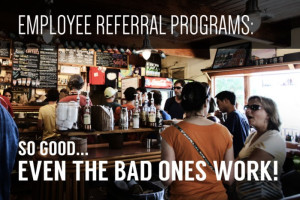
Back to the Future: Practical Tips on Using Big Data to Recruit
Last Monday we covered what Big Data is. No, it is not Starfleet Lieutenant Commander Data’s rapping name. Almost as cool, it is an abundance of information that can be leveraged by employers to improve their social recruiting. We also delved into how Big Data can be used to find candidates. How it can be a boon for talent-mining and help recruiters to separate the cream of the crop from a myriad of less creamy resumes. That sounds a bit gross, let’s move on.
The hiring process involves more than just getting candidates interested in your jobs. It is also about finding candidates who fit with your company culture, who will be a positive addition to your team, and who will be productive in their roles.
Finding the right candidates.
HR can leverage Big Data to find the best possible hires. Collecting and analyzing existing data about top performing employees and comparing it with information about prospective employees makes candidate selection a more scientific and successful process.
You might be surprised by the type of data that you should focus on. Yes, it’s a good idea to look at employment history and education, but things like hobbies, health, location and personality traits are as important, if not more so. Employees that sleep more, tend to take fewer sick days and, interestingly enough, employees that are active on multiple social networks tend to be more productive in general.
Comparing this kind of data from prospective candidates with your current top performers is a smart way to hire. A small warning though, it is important that you use a consistent template for each candidate you interview and pay close attention to any legal issues on discrimination when hiring based on personality traits vs experience.
Retention
Gathering and analyzing diverse data sets is also useful in making informed estimates about candidate retention. For example, employees who live closer to their place of work, stay in their positions longer. So when hiring it makes sense to consider a candidates location. As such gathering data of this kind is very helpful to the hiring process especially if attrition is an issue.
Big Data can also be used to understand why employees vacate positions and to come up with solutions to keep them. Google recently used Big Data to explain their unusually high attrition rate for female employees and then implement an effective solution to the problem.
As we all know, employee morale is an important influence on retention. Using apps like Morale.me is a great way to keep tabs on morale levels, so that adjustments to company culture can be made if needed.
Metrics!
Back to social recruiting for this one. Metrics are so important when it comes to recruiting strategy, and without detailed insights about how previous recruiting campaigns were conducted, there’s no way to measure success. Understanding how, where, and why previous social recruiting campaigns were successful (or not) is fundamental for effectively planning future campaigns.
That’s why Jobcast always provides metrics with our recruiting app, even for users on the free plan. Gathering and analyzing data about your previous campaigns will show you how applicants found your job posts, which social networks attract what kind of candidates, and how often you need to post jobs and content in order to get the best recruiting results.
These are just a few practical ways to use Big Data for better social recruiting practices and hiring in general. There are so many more! If you are interested in a more complex break down of Big Data, here are a serious of articles you can read. But be warned, they require a substantially greater time investment! Hopefully these ideas are helpful for your recruiting efforts.
Also, hopefully there really is a rapper called Big Data. If not… I may consider a change of careers. I wonder if there’s any good big data on the success rates of Star Trek-themed hip-hop groups who rap without emotion and like cats. Check.





